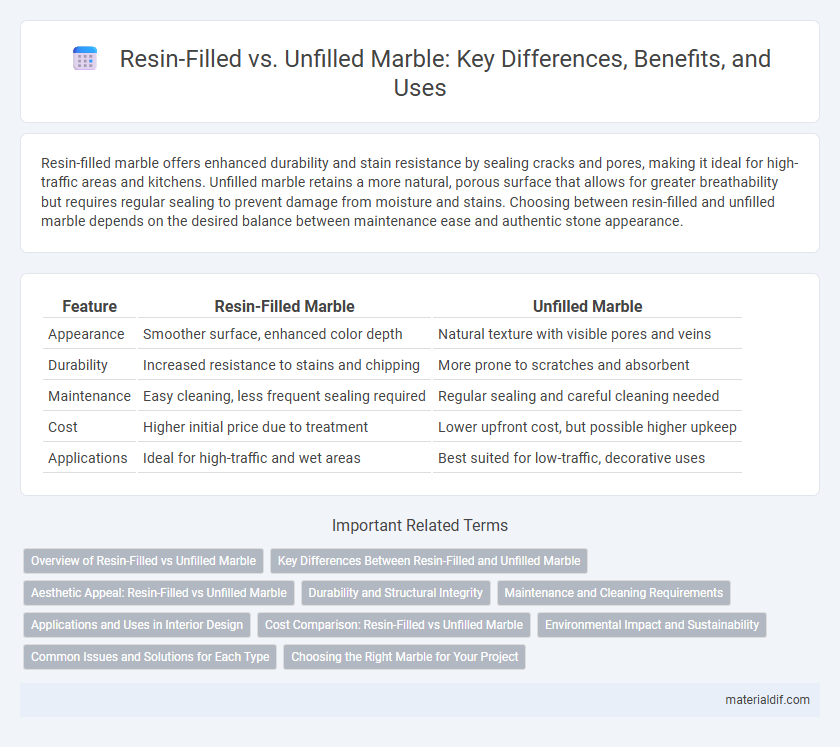Resin-filled marble offers enhanced durability and stain resistance by sealing cracks and pores, making it ideal for high-traffic areas and kitchens. Unfilled marble retains a more natural, porous surface that allows for greater breathability but requires regular sealing to prevent damage from moisture and stains. Choosing between resin-filled and unfilled marble depends on the desired balance between maintenance ease and authentic stone appearance.
Table of Comparison
| Feature | Resin-Filled Marble | Unfilled Marble |
|---|---|---|
| Appearance | Smoother surface, enhanced color depth | Natural texture with visible pores and veins |
| Durability | Increased resistance to stains and chipping | More prone to scratches and absorbent |
| Maintenance | Easy cleaning, less frequent sealing required | Regular sealing and careful cleaning needed |
| Cost | Higher initial price due to treatment | Lower upfront cost, but possible higher upkeep |
| Applications | Ideal for high-traffic and wet areas | Best suited for low-traffic, decorative uses |
Overview of Resin-Filled vs Unfilled Marble
Resin-filled marble features veins and fissures sealed with synthetic resin, enhancing durability and resistance to staining compared to unfilled marble, which retains natural pores and irregularities. The resin filling process reduces the marble's porosity, making it less susceptible to moisture absorption and easier to maintain. Unfilled marble displays the authentic, raw texture and natural imperfections that appeal to traditional aesthetic preferences but requires more frequent sealing and care to prevent damage.
Key Differences Between Resin-Filled and Unfilled Marble
Resin-filled marble features natural stone pores and fissures sealed with synthetic resin, enhancing durability and resistance to stains and moisture compared to unfilled marble, which remains porous and more vulnerable to damage. The resin filling process improves the polished surface's smoothness and reduces the risk of cracking, while unfilled marble may require more frequent sealing to maintain its appearance. In terms of cost, resin-filled marble typically commands a higher price due to the additional treatment, offering better longevity for high-traffic or moisture-prone applications.
Aesthetic Appeal: Resin-Filled vs Unfilled Marble
Resin-filled marble enhances aesthetic appeal by creating a smooth, glossy surface that highlights natural veins and reduces visible cracks, offering a polished and uniform look. Unfilled marble retains a more natural, porous texture with visible fissures and pits, appealing to those who prefer an authentic, rustic charm. The choice between resin-filled and unfilled marble depends on whether a sleek, refined finish or a raw, organic appearance aligns with the design vision.
Durability and Structural Integrity
Resin-filled marble enhances durability by sealing micro-cracks and pores, preventing moisture infiltration and reducing the risk of fractures. Unfilled marble maintains natural aesthetics but is more susceptible to chipping, staining, and structural weakening over time due to its porous nature. For high-traffic applications, resin-filled marble offers superior structural integrity, extending the lifespan of the stone under mechanical stress.
Maintenance and Cleaning Requirements
Resin-filled marble requires less frequent sealing and offers enhanced resistance to staining and etching, simplifying maintenance and cleaning routines. Unfilled marble, with its porous surface, demands regular sealing and more cautious cleaning to prevent absorbent damage from spills and acidic substances. Proper care of resin-filled marble involves gentle, pH-neutral cleaners, while unfilled marble necessitates immediate spill cleanup and periodic resealing to maintain its natural beauty.
Applications and Uses in Interior Design
Resin-filled marble is favored in interior design for its enhanced durability and resistance to staining, making it ideal for high-traffic areas like countertops and flooring. Unfilled marble, prized for its natural, porous texture, is commonly used in decorative applications such as wall cladding and fireplace surrounds where aesthetic appeal outweighs wear resistance. The choice between resin-filled and unfilled marble depends on balancing maintenance needs with the desired visual effect in residential or commercial interiors.
Cost Comparison: Resin-Filled vs Unfilled Marble
Resin-filled marble generally incurs higher upfront costs due to the labor-intensive filling process and specialized resin materials used to enhance durability and appearance. Unfilled marble tends to be less expensive initially but may require more frequent maintenance and potential repairs over time, increasing overall lifetime costs. Evaluating long-term expenses, resin-filled marble offers better value despite the initial premium by reducing the risk of cracks and stains.
Environmental Impact and Sustainability
Resin-filled marble incorporates synthetic resins to repair cracks and enhance durability, which can introduce non-biodegradable substances and complicate recycling processes, impacting environmental sustainability. Unfilled marble retains its natural state without chemical treatments, offering better biodegradability and a lower carbon footprint throughout its lifecycle. Choosing unfilled marble supports eco-friendly construction practices by minimizing synthetic material use and facilitating more sustainable waste management.
Common Issues and Solutions for Each Type
Resin-filled marble often faces yellowing and surface cracking, which can be mitigated by using UV-resistant resins and regular sealing to maintain durability and appearance. Unfilled marble is prone to staining and etching due to its porous nature, requiring prompt cleaning and application of penetrating sealers to prevent damage from acids and liquids. Both types benefit from routine maintenance, but choosing the appropriate cleaning agents and restoration methods tailored to resin-filled or unfilled marble ensures longevity and aesthetic preservation.
Choosing the Right Marble for Your Project
Resin-filled marble offers enhanced durability and stain resistance, making it ideal for high-traffic areas and kitchen countertops prone to spills and scratches. Unfilled marble retains a more natural appearance with its porous surface, suitable for low-traffic spaces or decorative applications where authenticity is prioritized. Selecting the right marble depends on balancing aesthetic preferences with functional requirements, considering factors like maintenance, exposure, and intended use.
Resin-filled vs Unfilled Infographic

 materialdif.com
materialdif.com